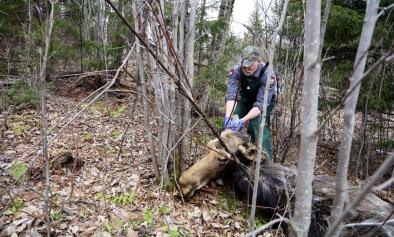Unraveling a century of global change impacts on winter bird distributions in the eastern United States
Study key findings & significance
- Winter has become the most rapidly warming season as the effects of human-caused climate change continue.
- Over the 90-year period from 1930 to 2019, temperatures rose, precipitation increased and humans’ use of land changed. Grasslands and wetlands declined and urbanization rose. Along the way, all 89 bird species studied experienced winter range shifts.
Author quotes
“Birds tell us that climate change is already having an effect on them, but not all birds are equally vulnerable to climate change. If we want to give birds the best chance at survival, habitat conservation needs to be part of our efforts to fight climate change.”
Sarah Saunders, a quantitative ecologist at Audubon and the study’s primary author
Abstract
One of the most pressing questions in ecology and conservation centers on disentangling the relative impacts of concurrent global change drivers, climate and land-use/land-cover (LULC), on biodiversity. Yet studies that evaluate the effects of both drivers on species’ winter distributions remain scarce, hampering our ability to develop full-annual-cycle conservation strategies. Additionally, understanding how groups of species differentially respond to climate versus LULC change is vital for efforts to enhance bird community resilience to future environmental change. We analyzed long-term changes in winter occurrence of 89 species across nine bird groups over a 90-year period within the eastern United States using Audubon Christmas Bird Count (CBC) data. We estimated variation in occurrence probability of each group as a function of spatial and temporal variation in winter climate (minimum temperature, cumulative precipitation) and LULC (proportion of group-specific and anthropogenic habitats within CBC circle). We reveal that spatial variation in bird occurrence probability was consistently explained by climate across all nine species groups. Conversely, LULC change explained more than twice the temporal variation (i.e., decadal changes) in bird occurrence probability than climate change on average across groups. This pattern was largely driven by habitat-constrained species (e.g., grassland birds, waterbirds), whereas decadal changes in occurrence probabilities of habitat-unconstrained species (e.g., forest passerines, mixed habitat birds) were equally explained by both climate and LULC changes over the last century. We conclude that climate has generally governed the winter occurrence of avifauna in space and time, while LULC change has played a pivotal role in driving distributional dynamics of species with limited and declining habitat availability. Effective land management will be critical for improving species’ resilience to climate change, especially during a season of relative resource scarcity and critical energetic trade-offs.
Related Content



